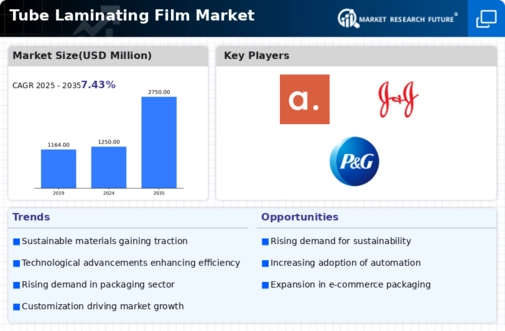Market Growth Projections
The Global Tube Laminating Film Market Industry is projected to experience substantial growth over the coming years. With a market value of 1250 USD Million anticipated in 2024, the industry is set to expand significantly, reaching an estimated 2750 USD Million by 2035. This growth trajectory indicates a compound annual growth rate of 7.43% from 2025 to 2035. Such projections reflect the increasing demand for tube laminating films across various sectors, including cosmetics, food, and pharmaceuticals, driven by trends in sustainability, technological advancements, and consumer preferences.
Growth in E-commerce and Online Retailing
The growth in e-commerce and online retailing has a profound impact on the Global Tube Laminating Film Market Industry. As more consumers turn to online shopping, the need for effective packaging solutions that ensure product safety during transit becomes paramount. Tube laminating films provide an excellent solution, offering protection while maintaining an attractive presentation. This trend is likely to drive demand for tube laminating films, as brands seek to enhance their packaging to meet the expectations of online shoppers. The market's expansion is expected to align with the overall growth of the e-commerce sector, further solidifying its position in the packaging industry.
Increased Focus on Product Differentiation
Increased focus on product differentiation is a key driver in the Global Tube Laminating Film Market Industry. As competition intensifies across various sectors, brands are striving to distinguish their products through innovative packaging solutions. Tube laminating films offer unique opportunities for customization, including various finishes, textures, and printing options. This ability to create visually appealing and distinctive packaging can significantly influence consumer purchasing decisions. Consequently, manufacturers are likely to invest in high-quality tube laminating films to enhance brand visibility and appeal, thereby contributing to the overall market growth.
Technological Advancements in Film Production
Technological advancements in film production play a crucial role in the Global Tube Laminating Film Market Industry. Innovations such as improved extrusion techniques and enhanced adhesive formulations are leading to higher quality films with better performance characteristics. These advancements not only enhance the durability and aesthetic appeal of tube laminating films but also reduce production costs. As a result, manufacturers can offer competitive pricing while maintaining quality, which is likely to attract more clients. The anticipated growth trajectory suggests that by 2035, the market could reach a valuation of 2750 USD Million, driven by these technological improvements.
Rising Demand for Sustainable Packaging Solutions
The Global Tube Laminating Film Market Industry experiences a notable increase in demand for sustainable packaging solutions. As consumers become more environmentally conscious, manufacturers are compelled to adopt eco-friendly materials. Tube laminating films, which can be produced from recyclable materials, align with this trend. For instance, brands are increasingly utilizing tube laminating films that reduce plastic waste, thereby appealing to a broader customer base. This shift is expected to contribute significantly to the market's growth, with projections indicating a market value of 1250 USD Million in 2024, reflecting a growing commitment to sustainability in packaging.
Expansion of the Cosmetic and Personal Care Sector
The expansion of the cosmetic and personal care sector significantly influences the Global Tube Laminating Film Market Industry. With the increasing popularity of beauty products packaged in tubes, manufacturers are focusing on developing innovative laminating films that enhance product visibility and shelf appeal. This trend is particularly evident in the rise of premium cosmetic brands that prioritize packaging aesthetics. As the global beauty market continues to flourish, the demand for high-quality tube laminating films is expected to grow, contributing to a projected compound annual growth rate of 7.43% from 2025 to 2035.














